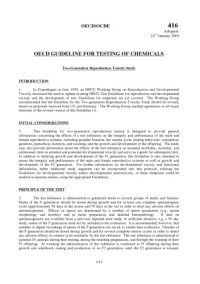This Test Guideline for two-generation reproduction testing is designed to provide general information concerning the effects of a test substance on the integrity and performance of the male and female reproductive systems, and on the growth and development of the offspring. The test substance is administered daily in graduated doses to several groups of males and females. Males and females of the Parent generation (5-9 weeks old) should be dosed during growth, during their mating, during the resulting pregnancies, and through the weaning of their first generation offspring. The administration of the substance is continued to first generation offspring during their growth into adulthood, mating and production of a second generation (until the weaning). The rat is the preferred species for testing. Each test and control group should contain a sufficient number of animals to yield preferably not less than 20 pregnant females at or near parturition. At least three dose levels and a concurrent control shall be used. It is recommended that the test substance be administered orally (by diet, drinking water or gavage). A limit test may be performed if no effects would be expected at a dose of 1000 mg/kg bw/d. The results of this study include: measurements (weighing, sperm parameters, oestrus cycle parameters and offspring parameters), clinical daily observations, as well as gross necropsy and histopathology. The findings of this two-generation reproduction toxicity study should be evaluated in terms of the observed effects including necropsy and microscopic findings. A properly conducted reproductive toxicity test should provide a satisfactory estimation of a no-effect level and an understanding of adverse effects on reproduction, parturition, lactation, postnatal development including growth and sexual development. Read more...
